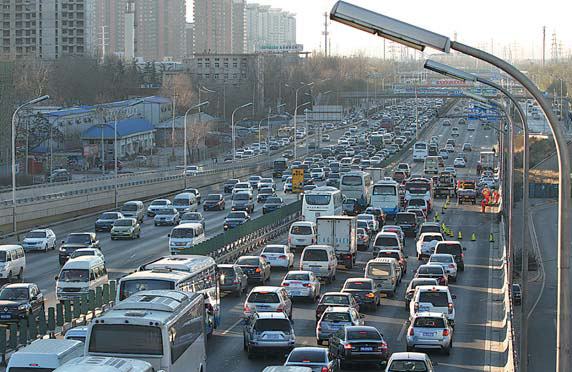Sustainable transport equals livable cities
Updated: 2016-01-30 08:19
By Liu Daizong(China Daily)
|
|||||||||
 |
|
The Fourth Ring Road in Beijing in a morning rush hour. City authorities are working on solutions to ease the pressures on traffic in the city. [Zhuo Ensen / For China Daily] |
To build a livable city that focuses on sustainable development, the authorities in Beijing have to come up with a package of solutions to the transportation problems, including severe traffic congestion. Among the solutions should be subtasks, including the shift from traffic governance that is aimed at meeting the existing demand for transportation, such as building roads and bridges, to managing the flow of transport by reducing people's dependence on cars through the regulation of parking norms and redistribution of road resources by making it easier for people to use bicycles and public transport vehicles to commute.
Automobiles on average contribute 30-40 percent of PM2.5 (particulate matter smaller than 2.5 microns in diameter that can be inhaled by and harm humans) in cities across the world. The figure in Beijing is about 31 percent.
Therefore, the need is to strike the right balance between traffic and economic development, because traffic jams increase travel costs and have a huge impact on the overall economy of a city.
Since urban mobility depends both on economic development and efficient transport networks, we have to change the way we commute to reduce traffic on the roads. For instance, while continuing to expand public transport networks we also have to increase the cost of driving cars.
Take London for example. By imposing congestion charge on vehicles entering the center of the city, it has not only made driving in downtown areas an expensive affair but also found a convenient way of raising part of the funds to further modernize the public transport system. This is a good way of facilitating urban mobility as well as of improving the living conditions of residents.
Related Stories
Beijing to support flextime in CBD and Zhongguancun areas to ease traffic 2016-01-27 16:23
Ride-sharing apps accused of slowing down traffic in Beijing 2016-01-26 10:41
Beijing mulls traffic ban for winter heating season 2016-01-22 10:39
One-way traffic prompts tourism revamp 2016-01-12 09:30
Beijing takes action to ease its thick traffic congestion 2016-01-04 10:17
Proper use of congestion fee can cut traffic jams 2015-12-15 08:04
Today's Top News
Inspectors to cover all of military
Britons embrace 'Super Thursday' elections
Campaign spreads Chinese cooking in the UK
Trump to aim all guns at Hillary Clinton
Labour set to take London after bitter campaign
Labour candidate favourite for London mayor
Fossil footprints bring dinosaurs to life
Buffett optimistic on China's economic transition
Hot Topics
Lunar probe , China growth forecasts, Emission rules get tougher, China seen through 'colored lens', International board,
Editor's Picks

|

|

|

|

|

|







